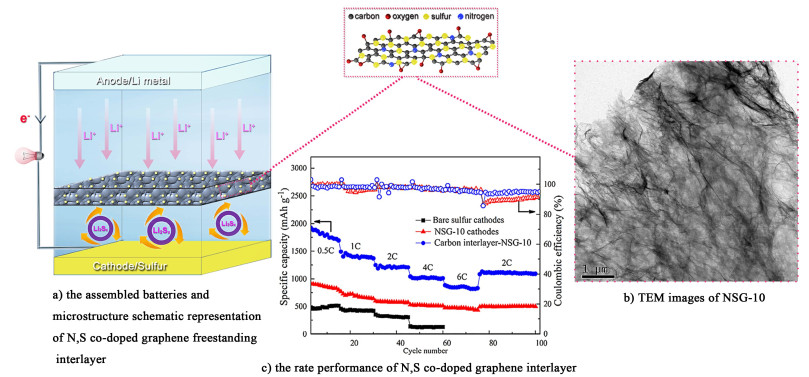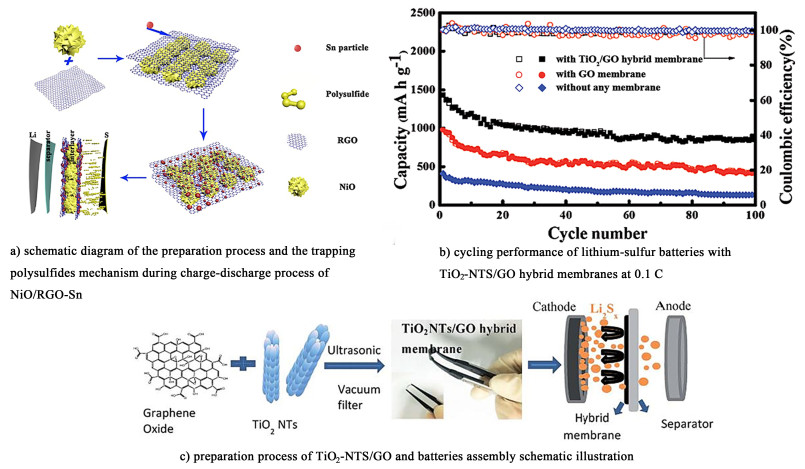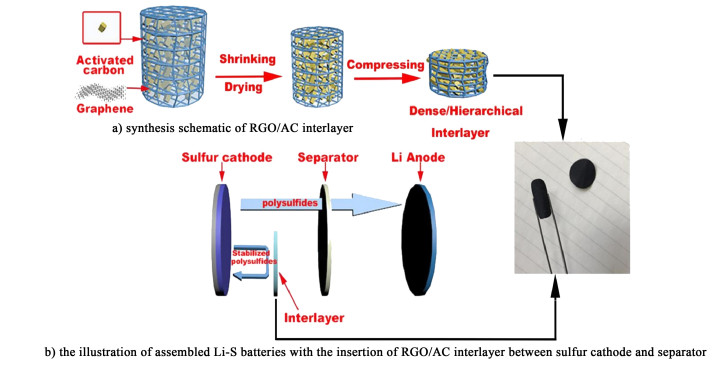2. 河南科技大学有色金属共性技术河南省协同创新中心, 河南 洛阳 471023;
3. 河南省有色金属材料与加工技术重点实验室, 河南 洛阳 471023
2. Collaborative Innovation Center of Nonferrous Metals of Henan Province, Henan University of Science and Technology, Henan Luoyang 471023, China;
3. Henan Key Laboratory of Non-Ferrous Materials Science&Processing Technology, Henan University of Science and Technology, Henan Luoyang 471023, China
随着社会的快速发展,人们对储能技术和设备的需求逐渐增大。由于传统的锂离子电池具有安全性好、无记忆效应、循环寿命长、对环境友好等优点,成为现今各种电子产品的首选电源。在锂离子二次电池中,与石墨、硅等负极材料相比,低比能量正极材料(LiFePO4和LiCoO2的理论比容量分别为170和274 mAh·g-1),在一定程度上限制了锂离子电池的能量密度和功率密度,因此亟需发展具有高比容量的电极材料。而硫是一种非常有前景的多电子氧化还原材料,有着极高的理论容量(1 672 mAh·g-1),且于锂金属组装成电池时,能展现出极高的理论能量密度(2 567 Wh·kg-1)[1-3],远高于传统的锂离子电池, 且硫具有成本低、储量丰富、对环境友好和工作温度范围大等优点,使其成为一种很有前景的可充电电池体系。在硫正极与锂负极之间的氧化还原过程如反应式(1)~(4)所示:
负(阳)极反应:
| $ 2{\rm{Li}} - 2{{\rm{e}}^ - } \to 2{\rm{L}}{{\rm{i}}^ + } $ | (1) |
正(阴)极反应:
| $ {\rm{S}} + 2{\rm{L}}{{\rm{i}}^ + } + 2{{\rm{e}}^ - } \to {\rm{L}}{{\rm{i}}_2}{\rm{S}} $ | (2) |
放电过程整个电池反应:
| $ 2{\rm{Li}} + {\rm{S}} \to {\rm{L}}{{\rm{i}}_2}{\rm{S}} $ | (3) |
伴随发生的副反应:
| $ {\rm{L}}{{\rm{i}}_2}{\rm{S}} + (x - 1){\rm{S}} \to {\rm{L}}{{\rm{i}}_2}{{\rm{S}}_x}(x = 2, 4, 6, 8) $ | (4) |
但是,在实际应用中还需要克服一些挑战,如单质硫和放电产物(Li2S2/Li2S)的电子绝缘特性、充放电产物密度差异造成的较大的体积变化(约80%)、可溶性多硫化锂引起的严重的穿梭效应和金属锂负极循环过程中锂枝晶的形成等,这些缺点阻碍了锂-硫电池的实际应用。其中最严重的即为多硫化物的穿梭效应,可溶性多硫化物通过电解液从正极向负极穿梭,与锂离子反应形成不溶性硫化锂(Li2S2/Li2S),导致活性物质持续损失、硫利用率降低、锂金属负极表面腐蚀和钝化[4-6]以及库仑效率的降低[7-8],进而导致电池容量快速下降使得循环寿命减少。
为了应对上述挑战,研究人员在正极改性[9-10]、电解液的优化[11-13]以及锂金属负极的保护和稳定[14-16]等方面做了大量的工作。为了抑制穿梭效应,人们将硫与各种多孔碳基质和导电聚合物[17-23]结合起来,以提高硫正极的导电性,并限制可溶性多硫化物的扩散。然而,这些材料的合成需要复杂的设计,如熔化和多次浸渍,有时还需要腐蚀性酸来蚀刻模板[24-27]和复杂的程序[23, 28-29]。在锂-硫电池中,最大的问题之一是多硫化物易溶于醚类有机液体电解质,并伴随着严重的穿梭效应,导致活性物质的损失和快速的容量衰减。而通过在正极或隔膜上覆盖一层阻挡层[23, 30],或在锂-硫电池的正极和隔膜之间插入一层自支撑单体夹层,使其有效地吸附多硫化物,可很大程度上阻止多硫化物的穿梭。许多研究人员通过对隔膜涂覆非极性和极性材料对其进行改性[31],通过在隔膜涂覆这些材料,聚硫化物通过物理吸附和化学吸附的方法被有效地限制在正极侧,并且涂覆材料具有良好的导电性,使多硫化物可在电化学反应中重复利用。除了在隔膜上涂覆材料以抑制多硫化物锂的穿梭之外,抑制多硫化物的另一种有效策略是在正极和隔膜之间插入1个自支撑夹层。Li等[32]从界面修饰的角度对在锂-硫电池插入中间层材料的文章进行了系统的综述,作者系统地阐述了不同类型材料和合成工艺对不同界面区域的影响,并对设计新的界面提供了新的观点。除此之外,Jeong等[33]综述了关于功能中间层隔膜/中间层的文章,旨在提出设计功能性隔膜/中间层的功能团(即PS、E和K功能)的新观点。
然而,他们没有详细概述通过选择一种材料作为基体,并与其他材料相结合得到的复合材料作为中间层材料对锂-硫电池性能的影响。中间层材料应满足以下条件:1)它的厚度能使锂离子和电子顺畅地扩散;2)能在正极一侧有效地固定或阻挡多硫化物;3)具有良好的导电性;4)夹层在电化学反应过程中要具有良好的耐腐蚀能力;5)夹层有一定的柔韧性防止装配电池时夹层破碎。根据这些特点,研究者们提出了制备以石墨烯为基体的复合夹层,这些石墨烯基中间层由于具有丰富的活性位点,良好的渗透性能,以及出色的导电能力,使得电池中电子转移更快,也可增大锂离子的扩散速率。因此,本论文主要总结了利用石墨烯基材料进行界面改性后对锂-硫电池性能的影响。石墨烯作为一种二维的碳同素异形体,具有优异的本征性能,如优异的导电能力和卓越的导热能力,且有着较大的比表面积,所以自2004年首次发现以来,它在多种储能系统中得到了广泛的应用[34-35]。本论文将重点对石墨烯基自支撑中间层在锂-硫电池界面设计领域的应用进行详细的综述,以期进一步突破锂-硫电池中多硫化物穿梭、活性物质利用率低、容量衰减快和倍率性能差的难题。
1 石墨烯 1.1 石墨烯石墨烯是一种以碳原子sp2杂化构成的具有许多六元环结构的二维共轭碳材料,研究者们广泛研究了其表面化学性质,并发现石墨烯具有良好的柔韧性和局域π电子传导特性[36]。目前已有研究人员将石墨烯作为自支撑中间层应用到锂-硫电池中,并展示了优秀的电化学性能。Zeng等[37]设计了一种插入硫电极和商用隔膜之间的氧化石墨烯(GO)基膜作为功能化中间层,它可以显著抑制聚硫化物的穿梭并可以提高容量,而且作者通过调节氧化时间来控制氧化石墨烯的氧化水平,在氧化过程中,随着石墨结构的逐渐消失,碳骨架先被氧化成羟基,再被氧化成环氧化物。采用氧化石墨烯中间层,不但提高了多硫化物的利用效率且增加了锂离子的储存,大大提高了硫正极的容量。
1.2 杂原子掺杂石墨烯尽管石墨烯作为聚硫化物吸附剂已被应用于锂-硫电池中,但其表面缺乏丰富的活性位点,对多硫化物的限制作用有限,因此研究人员逐渐将注意力转向在石墨烯表面掺杂异质原子,这种方法可以在石墨烯表面创造更多的活性位点,可以提高捕获聚硫化物的能力,从而使电池具有出色的循环性能和稳定性。Deng等[38]首次提出将三维氮掺杂石墨烯(3D-NG)材料作为隔膜和硫正极之间的功能自支撑夹层,电池容量有了显著提高。多孔结构的三维石墨烯具有多个氮掺杂活性位点,能够有效地将聚硫化物锚定在硫正极一侧,并有效地解决活性材料利用不充分和多硫化锂的穿梭问题。Xing等[39]研究发现,氮硫双原子共掺石墨烯海绵(NSG)作为锂-硫电池的活性碳夹层时,可以提供大量的活性位点,捕集多硫化锂,显著提高硫的利用率和电化学性能。Xing等利用图 1所示的碳叠氮化物还原氧化石墨烯,合成了类海绵状的石墨烯[图 1b)],当使用NSG作为中间层时,锂-硫电池在0.2 C的电流密度下放电,初始容量达到2 193 mAh·g-1,循环15圈后,以0.5 C的电流密度进行充放电,装配有NSG膜的电池仍能获得1 693 mAh·g-1的放电容量。即使在6 C的高电流密度下,它仍能提供829.4 mAh·g-1的高容量。此外,在连续增加的电流密度下循环75圈后,当电流密度再次重置为2.0 C时,电池的容量仍可以维持在1 090.5 mAh·g-1[图 1c)]。这些数据表明,含有丰富的硫酸盐基团和杂原子的石墨烯海绵有着优良的导电性并能有效地锚定聚硫化物(LiPSs),而且海绵状石墨烯的存在使得硫正极发挥出了更稳定的循环性能,明显地提高了电池的电化学性能。由于掺杂材料的活性位点丰富,Chong等[40]合成了一种N原子掺杂石墨烯纤维网膜,作为自支撑层插入到锂-硫电池中,也显示出较好的锚定聚硫的能力和良好的电化学性能。

|
| 图 1 a) 含有N、S共掺杂石墨烯自支撑中间层电池组装以及微观结构示意图[39];b)NSG-10材料的TEM图[39];c)N、S共掺杂石墨烯中间层的倍率性能图[39] Fig.1 a) The assembled batteries and microstructure schematic representation of N, S co-doped graphene freestanding interlayer[39]; b) TEM images of NSG-10[39]; c) The rate performance of N, S co-doped graphene interlayer[39] |
| |
碳质材料由于具有质量轻、导电性好、结构稳定等优点,已广泛应用于锂离子电池中。Wang等[41]认为还原氧化石墨烯(rGO)可作为限制多硫化锂穿梭的有效屏障。随着rGO基膜在正极和隔膜之间的插入,锂-硫电池的循环性能得到了提高,但是需要活化时间并且会有较大的容量衰减。因此,研究人员将科琴黑(CB)引入rGO中间层的二维结构中(rGO-CB)。随着CB的引入,rGO-CB表面变得粗糙且材料具有较高的气孔率。当m(rGO):m(CB)=2:1时,电池表现出最佳的电化学性能。研究人员认为,较高的气孔率提高了电解液的渗透速率,促进了活性材料的利用。由于中间层的嵌入,电池在0.1 C下释放了高达1 260 mAh·g-1的初始放电容量,即使在100个循环之后容量仍能保持在894 mAh·g-1。随后,Li等[42]通过简单的水热法和机械压缩将三维还原氧化石墨烯(3D rGO)与活性炭(AC)结合,制备成3D rGO/AC膜并作为功能夹层插入正极和隔膜之间(如图 2所示)。活性炭能有效地防止石墨烯的再充填,同时也为阻碍LiPSs的穿梭提供了锚定位点。随着夹层的引入,电池表现出优秀的性能。在0.1 C时,初始放电容量为1 078 mAh·g-1,100次循环后,容量仍能达到655 mAh·g-1,几乎是无夹层电池的2倍。
除了与这些轻量的含碳材料结合外,碳纳米管(纤维)由于优异的导电性、较大的比表面积且能够相互交织形成网络结构并能够有效增加离子的扩散速率的优点,引起了研究者们的广泛关注。石墨烯和碳纳米管(纤维)进行复合后,用于锂-硫电池中也展示了优异的性能。例如,Huang等[43]采用氧化石墨烯改性CNT合成多孔的GO/CNT薄膜作为中间层[图 3a)],具有高导电性和优异的锚定LiPSs能力,大大提高了锂-硫电池的电化学性能。在不同GO含量的GO/CNT材料中,1GO/2CNT中间层表现出最佳的电化学性能。CNTs均匀地分散在GO片中,且有着较多的表面孔洞,有利于电解液和多硫化物进入自支撑中间层的内部[图 3b)]。电池在0.1 C时的初始容量为1 370 mAh·g-1,在0.2 C时循环300圈后,仍保持671 mAh·g-1的高容量,且每圈容量衰减率约为0.043%[图 3c)]。Wang[44]将CNT与CNF@VS2和石墨烯复合膜层插入正极与隔膜之间时,电池显示出良好的电化学性能。
与碳纳米管相比,碳纳米纤维的渗透性和直径较小,很难更有效地限制多硫化锂的穿梭。为了解决这个问题,Zhang等[45]制备空心的碳纳米纤维,并将还原氧化石墨烯引入空心碳纳米纤维中构建三维导电框架,如图 4a)所示,该框架渗透电解液的速率更快且与正极可保持良好接触,有助于更多的活性材料参与反应。由于中间层具有较大的电解质渗透性和优异的离子和电子导电性,即使在高电流密度下,电池仍具有较高的循环稳定性和倍率能力。当电流密度为1.0 C时,循环400圈后,每圈的容量衰减为0.13%。Fan等[46]以大横向尺寸的石墨烯(LTG)为导电基体并作为硫的载体材料,以还原氧化石墨涂层碳纤维纸(RCF)作为添加层引入电池,可增加导电表面积并有效地缓冲体积变化,电池实现了长周期循环性能和高倍率性能。此外,有研究者将经济且对环境友好的生物材料碳化成碳纳米纤维,与石墨烯复合后将其用于锂-硫电池中也展示了优异的性能。Chai等[47]制备了丝状真菌稳定的石墨烯纳米片,形成如图 4b)所示的石墨烯嵌入碳纤维(GFC)导电多孔碳膜。在合成过程中,利用真菌提供N元素,使其能够吸收含硫物质。导电多孔碳膜作为硫正极和隔膜之间的导电夹层,为锂-硫电池提供了改进的循环性能。在电池中加入GFC薄膜后,0.5 C时可逆比容量达到1 250 mAh·g-1,300次循环后可逆比容量可达到698 mAh·g-1[图 4d)]。

|
| 图 4 a) HCNF/rGO中间层合成工艺示意图[45];b)GFC复合膜结构功能示意图[47];c)GFC膜的SEM图像[47];d)含有GFC膜的锂-硫电池在1.0 C的电流密度下的循环性能图[47] Fig.4 a) The schematic illustration of preparation process of HCNF/rGO interlayer[45]; b) The structure and function schematic of GFC films; c) the SEM images of GFC films and d) cycling performance of Li-S batteries with or without GFC films at the current density of 1.0 C[47] |
| |
近年来,过渡金属化合物因具有良好的催化性能、较高的比容量和功率密度、较低的成本和较大的比表面积引起了人们的广泛关注。由于这些优点,过渡金属化合物已被广泛应用于锂离子电池、钠离子电池、超级电容器和锂-硫电池中。但是,由于过渡金属化合物存在体积变化大和导电性较差的缺点,在储能装置中应用也面临着许多挑战,因此许多研究人员选择了导电性较好的材料(石墨烯、碳纳米管/纤维、活性炭等)与过渡金属化合物复合的材料并将其应用于上述电子器件中。
由于石墨烯的物理锚定多硫化物的能力有限,为了进一步提高阻碍聚硫化物的穿梭的能力,研究人员逐渐将目光转向如金属氧化物、金属硫化物等极性材料上。通过将这些极性材料与石墨烯结合,锂-硫电池的电化学性能明显改善。Guo等[48]报道了一种包含二氧化锰纳米线和石墨烯纳米线的复合薄膜作为自支撑层插入隔膜和正极之间,在4.0 C大电流密度下循环400次后获得了545 mAh·g-1的优异性能。在这篇报道之后,其他研究小组也报道将石墨烯和金属氧化物复合作为中间层的工作。例如Li等[49]报道了一种还原氧化石墨烯(rGO)与NiO和锡纳米颗粒复合的三维独立夹层作为锂-硫电池的中间层,如图 5a)所示。具有分层中空结构的NiO可催化多硫化物向Li2S2和Li2S的转变;而柔韧性较好的rGO可以充分缓解硫正极的体积变化。所以电池具有较好的循环性能和倍率性能。此后,由于一维结构的纳米材料如纳米棒、纳米线、纳米带、纳米纤维等,除了具有较大的电解液-电极接触面积的长宽比外,还可以缩短离子扩散长度和电子扩散路径,与颗粒材料相比,一维纳米材料可以有效促进离子和电子的传输。Guo等[50]将一维纳米结构的石墨烯和V2O5纳米线交织的新型夹层,由于此夹层具有导电性能和力学性能突出、集成性强等优点,大大延长了锂-硫电池的循环寿命,提高了硫的再利用率。同年,Song等[51]通过简单的抽滤方法制备了一种二氧化钛纳米管和氧化石墨烯(TiO2-NTs/GO)膜,TiO2-NTs/GO的制备与过程如图 5c)所示。Song等认为,TiO2-NTs/GO复合膜的优异的柔韧性,可以防止循环过程中中间层的破碎,不但有利于电池组装且电池在循环稳定性和放电容量方面都有显著的改善。组装有二氧化钛NTs/GO膜的电池循环100次后,仍具有895.7 mAh·g-1的放电比容量,相应的容量损失仅为每循环0.409%[图 5b)]。由于相互连接的石墨烯导电网络和二氧化钛NTs的协同作用,电池的循环稳定性显著提高。此外,还有研究小组报道了石墨烯和金属氧化物组成的其他复合中间层,证明锂-硫电池在加入中间层后具有增强的电化学性能[52]。最近,Yi等[53]在Li-S电池中开发了一种独立的石墨烯泡沫(GF)作为中间层,并通过原子层沉积(ALD),沉积了一层ZnO纳米层。此中间层不仅增大了其导电性,而且使多硫化物的固定化达到最大程度,因此随着中间层的插入,锂-硫电池的容量和循环性能都得到了很大的提高。

|
| 图 5 a) NiO/RGO-Sn自支撑膜的合成工艺示意图以及充放电过程中多硫化物吸收的机理图[49];b)TiO2-NTS/GO在电流密度为0.1 C下的循环性能图[51];c)TiO2-NTS/GO的制备流程以及电池组装示意图[51] Fig.5 a) Schematic diagram of the preparation process and the trapping polysulfides mechanism during charge-discharge process of NiO/RGO-Sn[49]; b)cycling performance of lithium-sulfur batteries with TiO2-NTS/GO hybrid membranes at 0.1 C and c) preparation process of TiO2-NTS/GO and batteries assembly schematic illustration[51] |
| |
导电聚合物以其高导电性、低密度、易制备和独特的物理化学性能已广泛应用于储能电池中。由于它们与LiPSs有很强的亲和力,所以研究者们将其作为硫宿主或功能化夹层应用于锂-硫电池中。Yin等[54]选择GO作为支撑原位聚合苯胺过程的自支撑基体,最终将聚苯胺-氧化石墨烯膜(PANI-GO)作为功能中间层嵌入硫电极和隔膜之间,通过醌型环的亚胺基团与LiPSs的强相互作用阻碍多硫化锂的穿梭。PANI-GO膜不仅能有效地通过物理拦截和化学吸附阻碍溶解的LiPSs的穿梭,而且其优秀的导电网络增强了硫的再活化和再利用。此外,由于PANI-GO作为第二集流体具有很强的电子/离子转移能力,且PANI-GO的多孔堆积结构可较多的容纳LiPSs,使锂-硫电池具有良好的循环稳定性和优秀的倍率性能。
如上述所示的一些金属氧化物虽然促进了可溶性LiPSs向不溶性Li2S2和Li2S转化的催化能力,但大多数金属氧化物的导电性相对较差,这可能导致更高的电池电阻和更低的倍率容量。因此,应重点提高金属氧化物的导电性,或将氧化物与其他导电性较高的材料(如碳材料)混合。Wang等[44]整合了1个多组分三明治结构夹层,作为插入硫正极和隔膜之间的独立夹层,使锂-硫电池具有出色的电化学性能。在该结构中,作者以CNF为基体,石墨烯为第二集流体,有效地提高了电池的导电性,引入VS2/CNF后,中间层显示出良好的协同效应,可以有效捕获LiPSs并抑制自放电效应(图 6)。将制备的多组分中间层插入电池内,显示出增强的氧化还原动力学和优良的倍率性能。如图 6c)所示,含有VS2的CNT比纯CNT表现出更强的吸附能力,这表明VS2中的极性V—S键促进了对多硫化物的吸附。循环曲线表明,即使在5.6 mg·cm-1的高硫负载下循环45圈后,在0.3 C电流密度下,含CNF@VS2/CNT@GN夹层的电池仍保持685 mAh·g-1的可逆容量,容量保持率为91.33%[图 6d)],表明CNF@VS2/CNT@GN不但能增强循环稳定性并可以降低电池的极化。

|
| 图 6 a) CNF@VS2/CNT@GN和b) CNF@CNT@GN中间层在Li-S电池中的作用示意图;c)加入等量CNT和VS2/CNT前后Li2S6溶液的颜色对比图;d)在硫载量为5.612 mg·cm-2下,CNF@VS2/CNT@GN的循环性能图;e)在扫描速率为0.2 mV·s-1时CNF@VS2/CNT@GN的CV曲线图[44] Fig.6 The function of a) CNF@VS2/CNT@GN and b) CNF@CNT@GN interlayer in Li-S batteries; c) color variance of Li2S6 solutions with equal quality CNT and VS2/CNT, respectively; d) cyclic performance of Li-S batteries with CNF@VS2/CNT@GN at a high sulfur loading of 5.612 mg·cm-2 and e) CV profiles of CNF@VS2/CNT@GN at a scan rate of 0.2 mV·s-1[44] |
| |
锂-硫电池是高比能能源储存器件发展道路上的一个重要方向,在过去的几年里,为了解决硫正极目前面临的各种问题,研究者们提出了多种策略来改善锂-硫电池的性能,也研究了各种各样的夹层材料,并探索了将多种不同的材料结构与石墨烯复合,得到可有效吸附多硫化物的自支撑中间层。研究者们充分考虑了自支撑中间层的电子和离子导电率、均匀性、可控厚度以及其它表面性能,希望可以增强锂-硫电池的循环寿命,增加硫的利用率,使电池的循环更加稳定。在众多的基底材料中,石墨烯已经被证实是一种很有前景的可应用于锂-硫电池的材料,由于其具有高的柔韧性、大的比表面积和卓越的电导能力,能够解决硫导电性差和在充放电过程中正极体积变化大的问题,且在一定程度上限制易溶还原性聚硫化物的穿梭,相应的提高了硫的利用率,并提高了电池的循环寿命和稳定性,推动了锂-硫电池的发展。
但是在电池循环过程中,硫正极的体积变化、聚硫化物的穿梭等问题仍没有在根本上得到解决。迄今为止的文献报道中仅仅给出成键的证据或者通过物理和电化学表征证明确实抑制了聚硫化物的穿梭,却没有仔细讨论不同的石墨烯基自支撑中间层、材料的晶体结构或者无定型结构、膜层厚度以及比表面积对电池性能的影响。所以在这些方面需要更细致和更有深度的研究,才能使锂-硫电池得到实际的投产使用。
| [1] |
Manthiram A, Fu Y, Chung S H, et al. Rechargeable lithium-sulfur batteries[J]. Chemical Reviews, 2014, 114(23): 11751-11787. DOI:10.1021/cr500062v |
| [2] |
Bruce P G, Hardwick L J, Abraham K M. Lithium-Air and lithium-sulfur batteries[J]. MRS Bulletin, 2011, 36(7): 506-512. DOI:10.1557/mrs.2011.157 |
| [3] |
Yin Y, Xin S, Guo Y, et al. Lithium-Sulfur batteries:Electrochemistry, materials, and prospects[J]. Angewandte Chemie International Edition, 2013, 52(50): 13186-13200. DOI:10.1002/anie.201304762 |
| [4] |
Cao D, Jiao Y, Cai Q, et al. Stable lithium-sulfur full cells enabled by dual functional and interconnected mesocarbon arrays[J]. Journal of Materials Chemistry A, 2019, 7(7): 3289-3297. DOI:10.1039/C8TA10351H |
| [5] |
Chen Y, Abbas S A, Kaisar N, et al. Mitigating metal dendrite formation in lithium-sulfur batteries via morphology-tunable graphene oxide interfaces[J]. ACS Applied Materials & Interfaces, 2019, 11(2): 2060-2070. |
| [6] |
Liu S, Li J, Yan X, et al. Superhierarchical cobalt-embedded nitrogen-doped porous carbon nanosheets as two-in-one hosts for high-performance lithium-sulfur batteries[J]. Advanced Materials, 2018. DOI:10.1002/adma.201706895 |
| [7] |
Huang J, Zhuang T, Zhang Q, et al. Permselective graphene oxide membrane for highly stable and anti-self-discharge lithium-sulfur batteries[J]. ACS Nano, 2015, 9(3): 3002-3011. DOI:10.1021/nn507178a |
| [8] |
Zhou G, Pei S, Li L, et al. A graphene-pure-sulfur sandwich structure for ultrafast, long-life lithium-sulfur batteries[J]. Advanced Materials, 2014, 26(4): 625-631. DOI:10.1002/adma.201302877 |
| [9] |
Chen L, Yang W W, Liu J G, et al. Decorating CoSe2 hollow nanospheres on reduced graphene oxide as advanced sulfur host material for performance enhanced lithium-sulfur batteries[J]. Nano Research, 2019, 12(11): 2743-2748. DOI:10.1007/s12274-019-2508-3 |
| [10] |
Li Z, Yuan L, Yi Z, et al. A dual coaxial nanocable sulfur composite for high-rate lithium-sulfur batteries[J]. Nanoscale, 2014, 6(3): 1653-1660. DOI:10.1039/C3NR04347A |
| [11] |
Barghamadi M, Best A S, Bhatt A I, et al. Effect of LiNO3 additive and pyrrolidinium ionic liquid on the solid electrolyte interphase in the lithium-sulfur battery[J]. Journal of Power Sources, 2015, 295: 212-220. DOI:10.1016/j.jpowsour.2015.06.150 |
| [12] |
Ding N, Zhou L, Zhou C, et al. Building better lithium-sulfur batteries:From LiNO3 to solid oxide catalyst[J]. Scientific Reports, 2016. DOI:10.1038/srep33154 |
| [13] |
Ebadi M, Lacey M J, Brandell D, et al. Density functional theory modeling the interfacial chemistry of the LiNO3 additive for lithium-sulfur batteries by means of simulated photoelectron spectroscopy[J]. The Journal of Physical Chemistry C, 2017, 121(42): 23324-23332. DOI:10.1021/acs.jpcc.7b07847 |
| [14] |
Yan C, Cheng X, Tian Y, et al. Lithium metal anodes:Dual-layered film protected lithium metal anode to enable dendrite-free lithium deposition[J]. Advanced Materials, 2018. DOI:10.1002/adma.201870181 |
| [15] |
Pei F, Fu A, Ye W, et al. Robust lithium metal anodes realized by lithiophilic 3D porous current collectors for constructing high-energy lithium-sulfur batteries[J]. ACS Nano, 2019, 13(7): 8337-8346. DOI:10.1021/acsnano.9b03784 |
| [16] |
Paolella A, Demers H, Chevallier P, et al. A platinum nanolayer on lithium metal as an interfacial barrier to shuttle effect in Li-S batteries[J]. Journal of Power Sources, 2019, 427: 201-206. DOI:10.1016/j.jpowsour.2019.04.078 |
| [17] |
Zhou Y, Zhou C, Li Q, et al. Enabling prominent high-rate and cycle performances in one lithium-sulfur battery:designing permselective gateways for Li+ transportation in holey-CNT/S cathodes[J]. Advanced Materials, 2015, 27(25): 3774-3781. DOI:10.1002/adma.201501082 |
| [18] |
Zhang J, Shi Y, Ding Y, et al. In situ reactive synthesis of polypyrrole-MnO2 coaxial nanotubes as sulfur hosts for high-performance lithium-sulfur battery[J]. Nano Letters, 2016, 16(11): 7276-7281. DOI:10.1021/acs.nanolett.6b03849 |
| [19] |
Zhang J, Shi Y, Ding Y, et al. A conductive molecular framework derived Li2S/N, P-codoped carbon cathode for advanced lithium-sulfur batteries[J]. Advanced Energy Materials, 2017. DOI:10.1002/aenm.201602876 |
| [20] |
Pang Q, Tang J, Huang H, et al. A nitrogen and sulfur dual-doped carbon derived from polyrhodanine@Cellulose for advanced lithium-sulfur batteries[J]. Advanced Materials, 2015, 27(39): 6021-6028. DOI:10.1002/adma.201502467 |
| [21] |
Liang X, Hart C, Pang Q, et al. A highly efficient polysulfide mediator for lithium-sulfur batteries[J]. Nature Communications, 2015. DOI:10.1038/ncomms6682 |
| [22] |
Li G, Sun J, Hou W, et al. Three-Dimensional porous carbon composites containing high sulfur nanoparticle content for high-performance lithium-sulfur batteries[J]. Nature Communications, 2016. DOI:10.1038/ncomms10601 |
| [23] |
Ji X, Lee K T, Nazar L F. A highly ordered nanostructured carbon-sulphur cathode for lithium-sulphur batteries[J]. Nature Materials, 2009, 8(6): 500-506. DOI:10.1038/nmat2460 |
| [24] |
Gu H, Zhang R, Wang P, et al. Construction of three-dimensional ordered porous carbon bulk networks for high performance lithium-sulfur batteries[J]. Journal of Colloid and Interface Science, 2019, 533: 445-451. DOI:10.1016/j.jcis.2018.08.093 |
| [25] |
Wu R, Chen S, Deng J, et al. Hierarchically porous nitrogen-doped carbon as cathode for lithium-sulfur batteries[J]. Journal of Energy Chemistry, 2018, 27(6): 1661-1667. DOI:10.1016/j.jechem.2018.02.010 |
| [26] |
Wu Z, Wang W, Wang Y, et al. Three-Dimensional graphene hollow spheres with high sulfur loading for high-performance lithium-sulfur batteries[J]. Electrochimica Acta, 2017, 224: 527-533. DOI:10.1016/j.electacta.2016.12.072 |
| [27] |
Zhang P, Yue W, Li R. Uniform yolk-shell Fe3O4@nitrogen-doped carbon composites with superior electrochemical performance for lithium-ion batteries[J]. Electrochimica Acta, 2018, 282: 595-601. DOI:10.1016/j.electacta.2018.06.102 |
| [28] |
Tao X, Wang J, Ying Z, et al. Strong sulfur binding with conducting magnéli-phase TinO2n-1 Nanomaterials for improving lithium-sulfur batteries[J]. Nano Letters, 2014, 14(9): 5288-5294. DOI:10.1021/nl502331f |
| [29] |
Xiao L, Cao Y, Xiao J, et al. A soft approach to encapsulate sulfur:polyaniline nanotubes for lithium-sulfur batteries with long cycle life[J]. Advanced Materials, 2012, 24(9): 1176-1181. DOI:10.1002/adma.201103392 |
| [30] |
He G, Evers S, Liang X, et al. Tailoring porosity in carbon nanospheres for lithium-sulfur battery cathodes[J]. ACS Nano, 2013, 7(12): 10920-10930. DOI:10.1021/nn404439r |
| [31] |
Ahn J H, Shin H J, Abbas S, et al. Plasma-Functionalized carbon-layered separators for improved performance of lithium sulfur batteries[J]. Journal of Materials Chemistry A, 2019, 7(8): 3772-3782. DOI:10.1039/C8TA10795E |
| [32] |
Li X, Sun X. Interface design and development of coating materials in lithium-sulfur batteries[J]. Advanced Functional Materials, 2018, 28(30): 1801323. DOI:10.1002/adfm.201801323 |
| [33] |
Jeong Y C, Kim J H, Nam S, et al. Rational design of nanostructured functional interlayer/separator for advanced Li-S batteries[J]. Advanced Functional Materials, 2018. DOI:10.1002/adfm.201707411 |
| [34] |
Georgakilas V, Tiwari J N, Kemp K C, et al. Noncovalent functionalization of graphene and graphene oxide for energy materials, biosensing, catalytic, and biomedical applications[J]. Chemical Reviews, 2016, 116(9): 5464-5519. DOI:10.1021/acs.chemrev.5b00620 |
| [35] |
Karousis N, Suarez-Martinez I, Ewels C P, et al. Structure, properties, functionalization, and applications of carbon nanohorns[J]. Chemical Reviews, 2016, 116(8): 4850-4883. DOI:10.1021/acs.chemrev.5b00611 |
| [36] |
梁彤祥, 刘娟, 王晨. 石墨烯的电子结构及其应用进展[J]. 材料工程, 2014, 42(6): 89-96. Liang Tongxiang, Liu Juan, Wang Chen. Electronic structure of graphene and its application advances[J]. Journal of Materials Engineering, 2014, 42(6): 89-96. (in Chinese) |
| [37] |
Zeng Q, Leng X, Wu K, et al. Electroactive cellulose-supported graphene oxide interlayers for Li-S batteries[J]. Carbon, 2015, 93: 611-619. DOI:10.1016/j.carbon.2015.05.095 |
| [38] |
Deng H, Yao L, Huang Q, et al. Highly improved electrochemical performance of Li-S batteries with heavily nitrogen-doped three-dimensional porous graphene interlayers[J]. Materials Research Bulletin, 2016, 84: 218-224. DOI:10.1016/j.materresbull.2016.08.014 |
| [39] |
Xing L, Xi K, Li Q, et al. Nitrogen, sulfur-codoped graphene sponge as electroactive carbon interlayer for high-energy and -power lithium-sulfur batteries[J]. Journal of Power Sources, 2016, 303: 22-28. DOI:10.1016/j.jpowsour.2015.10.097 |
| [40] |
Chong W, Xiao F, Yao S, et al. Nitrogen-Doped graphene fiber webs for multi-battery energy storage[J]. Nanoscale, 2019, 11(13): 6334-6342. DOI:10.1039/C8NR10025J |
| [41] |
Wang X, Wang Z, Chen L. Reduced graphene oxide film as a shuttle-inhibiting interlayer in a lithium-sulfur battery[J]. Journal of Power Sources, 2013, 242: 65-69. DOI:10.1016/j.jpowsour.2013.05.063 |
| [42] |
Li H, Sun L, Zhang Y, et al. Enhanced cycle performance of Li/S battery with the reduced graphene oxide/activated carbon functional interlayer[J]. Journal of Energy Chemistry, 2017, 26(6): 1276-1281. DOI:10.1016/j.jechem.2017.09.009 |
| [43] |
Huang J, Xu Z, Abouali S, et al. Porous graphene oxide/carbon nanotube hybrid films as interlayer for lithium-sulfur batteries[J]. Carbon, 2016, 99: 624-632. DOI:10.1016/j.carbon.2015.12.081 |
| [44] |
Wang L, He Y, Shen L, et al. Ultra-Small self-discharge and stable lithium-sulfur batteries achieved by synergetic effects of multicomponent sandwich-type composite interlayer[J]. Nano Energy, 2018, 50: 367-375. DOI:10.1016/j.nanoen.2018.05.043 |
| [45] |
Zhang Z, Wang G, Lai Y, et al. A freestanding hollow carbon nanofiber/reduced graphene oxide interlayer for high-performance lithium-sulfur batteries[J]. Journal of Alloys.and Compounds, 2016, 663: 501-506. DOI:10.1016/j.jallcom.2015.11.120 |
| [46] |
Fan C, Li H, Zhang L, et al. Fabrication of functionalized polysulfide reservoirs from large graphene sheets to improve the electrochemical performance of lithium-sulfur batteries[J]. Physical Chemistry Chemical Physics, 2015, 17(36): 23481-23488. DOI:10.1039/C5CP02531A |
| [47] |
Chai L, Wang J, Wang H, et al. Porous carbonized graphene-embedded fungus film as an interlayer for superior Li-S batteries[J]. Nano Energy, 2015, 17: 224-232. DOI:10.1016/j.nanoen.2015.09.001 |
| [48] |
Guo Y, Zhao G, Wu N, et al. Efficient synthesis of graphene nanoscrolls for fabricating sulfur-loaded cathode and flexible hybrid interlayer toward high-performance Li-S batteries[J]. ACS Applied Materials & Interfaces, 2016, 8(50): 34185-34193. |
| [49] |
Li C, Dong S, Guo D, et al. Ternary NiO/RGO-Sn hybrid flexible freestanding film as interlayer for lithium-sulfur batteries with improved performance[J]. Electrochimica Acta, 2017, 251: 43-50. DOI:10.1016/j.electacta.2017.07.164 |
| [50] |
Guo Y, Zhang Y, Zhang Y, et al. Interwoven V2O5 nanowire/graphene nanoscroll hybrid assembled as efficient polysulfide-trapping-conversion interlayer for long-life lithium-sulfur batteries[J]. Journal of Materials Chemistry A, 2018, 6(40): 19358-19370. DOI:10.1039/C8TA06610H |
| [51] |
Song H, Zuo C, Xu X, et al. A thin TiO2 NTs/GO hybrid membrane applied as an interlayer for lithium-sulfur batteries[J]. RSC Advances, 2018, 8(1): 429-434. DOI:10.1039/C7RA10858C |
| [52] |
Yue X, Li X, Meng J K, et al. Padding molybdenum net with Graphite/MoO3 composite as a multi-functional interlayer enabling high-performance lithium-sulfur batteries[J]. Journal of Power Sources, 2018, 397: 150-156. DOI:10.1016/j.jpowsour.2018.07.017 |
| [53] |
Yi R, Liu C, Zhao Y, et al. A light-weight free-standing graphene foam-based interlayer towards improved Li-S cells[J]. Electrochimica Acta, 2019, 299: 479-488. DOI:10.1016/j.electacta.2019.01.015 |
| [54] |
Yin L, Dou H, Wang A, et al. A functional interlayer as a polysulfides blocking layer for high-performance lithium-sulfur batteries[J]. New Journal of Chemistry, 2018, 42(2): 1431-1436. DOI:10.1039/C7NJ03675B |
 2020, Vol. 37
2020, Vol. 37







